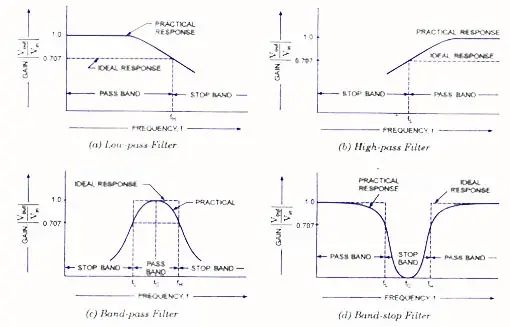The most widely used active filters are
(i) low-pass
(ii) high-pass
(iii) band-pass
(iv) band-stop or band reject (also called the band-elimination or notch) and
(v) all-pass filters.
All of these filters use op-amps as the active elements and R-C networks. Although the 741 type op-amp operates satisfactorily in these filter circuits, high-speed op-amps like the LM 318 or ICL 8017 improve the performance of the filter circuits through their increased slew rates and higher unity GBW.
Low Pass Filter:
A low-pass filter has a constant gain from 0 Hz to a high cut-off frequency fH. Therefore the bandwidth is also fH. At high cut-off frequency fH the gain is reduced by 3 db and for f > fH it decreases with the increase in input frequency. The frequencies between 0 and /H are known as passband frequencies while the range of frequencies beyond fH are attenuated and are therefore called the stop-band frequencies.
Frequency response of a low-pass filter is illustrated in figure. As indicated by the dashed line, an ideal filter has no loss in the passband and infinite loss (or attenuation) in the stop-band. But ideal filter response is not practical because linear networks cannot produce the discontinuities. However, it is possible to achieve a practical response that approximates the ideal response by employing special design techniques, precision components and high speed op-amps such as LM 318 or ICL 8017.
Butterworth, Chebyshev, Bessel and Elliptic filters are some of the most widely employed practical filters for approximating the ideal response. The key characteristic of the Butterworth filter is that it has a flat passband as well as a flat stopband. This is the reason that it is sometimes called a flat-flat filter. The Chebyshev filter has a ripple passband but a flat stopband. The Elliptic filter has a ripple passband as well as a ripple stopband. Generally, the Elliptic filter provides the best stopband response among the three.
High Pass Filter:
A high-pass filter with a stopband 0 < f < fL and a passband f > fL is shown in figure.b. Here /L is the lower cut-off frequency and / is the operating frequency.
Band Pass Filter:
A bandpass filter has a passband between two cut-off frequencies fH and fL where fH > fL and two stopbands at 0 < f < fL and f > fH. The bandwidth of the bandpass filter is, therefore, equal to fH – fL. All these are obvious from the frequency response of a bandpass filter illustrated in fig. c
Band Stop Filter:
Band-stop filter is exactly opposite to the bandpass filter in performance i.e., it has a bandstop between two cut-off frequencies fH and fL and two passbands, 0 < f < fL and f > fH. The frequency response of a band-stop filter is illustrated in fig. d. In figs. (c) and (d), fc is called the centre frequency, since it is approximately at the centre of the passband or stopband.
All Pass Filter:
Fig. (e) illustrates the phase shift between the input and output voltages of an all-pass filter. This filter passes all frequencies equally well (i.e. the output and input voltages are equal in magnitude for all frequencies) but with the phase shift between the two; phase shift being a function of the input frequency. The highest frequency upto which the magnitudes of the input and output remain equal depends on the unity GBW of the op-amp. At this frequency, however, the phase shift between the input and output is maximum. Bessel filter having a minimal phase shift is used, even though its cut-off characteristics are not very sharp.
Before proceeding with specific types of filters, let the filter characteristics, especially in the stopband region, be re-examined. As illustrated in figs (a) to (d), the actual response curves of the filters in the stopband either steadily increase or decrease with the increase in frequency. The rate at which the gain of the filter varies in the stopband is determined by the order of filter. For instance, for the first-order low-pass filter, in the case of Butterworth filters, the gain rolls off at the rate of 20 db per decade in the stopband i.e. for f > fH. On the other hand, for the second-order low-pass filter the roll-off rate is 40 db per decade, and so on
Share this on your favourite network








gümüşhane
ReplyDeletebilecik
erzincan
nevşehir
niğde
UX6X